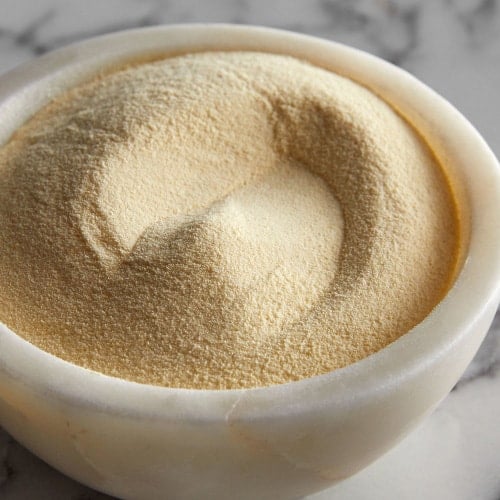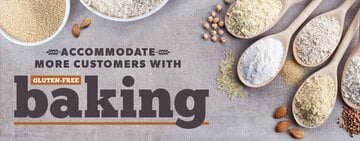Dough Conditioner: What It Is and How to Use It
One of the challenges you may encounter if you’re looking to start a bakery is achieving consistency between your products. With all the ingredients that go into a loaf of bread like fats, milk, sugar, and flour, along with other external variables, it can be a feat to get two loaves looking the same. That is where dough conditioners come in! We’ll explore what dough conditioner does and how it can save you time and effort in your day-to-day routine.
Shop All Dough ConditionersWhat Is Dough Conditioner?

Dough conditioner is any baking ingredient that improves the production and consistency of a dough. The purpose of a dough conditioner is to simplify and expedite the bread-making process. Depending on the ingredients in a dough conditioner, different reactions occur in the dough.
Any additional ingredients aside from flour, yeast, and water can be considered a dough conditioner. However, dough conditioners can be commercially made in the form of concentrates or dry mixes from a proprietary blend of natural chemicals, agents, and ingredients. Dough conditioners will often be found in bread flour, quick doughs, and straight dough systems.
Dough Enhancer vs Dough Conditioner
Dough enhancers, dough improvers, and dough conditioners are essentially different terms for the same thing. All of these terms are used to refer to ingredients that help expedite the dough process and produce consistent results.
Oftentimes you’ll also find dough conditioners listed as "flour treatment agents" or "improving agents" as well. These names refer to the fact that dough conditioner positively impacts the dough’s strength, development, or workability.
Dough Enhancer Benefits
Many bakers choose to use add dough conditioners to their collection of bread-making supplies for the benefits that they provide. Dough conditioners assist with the following functions:
- Expedites the rising and proofing process to save time and effort in the bread-making process
- Makes the dough easier to manage and more tolerant to handling
- Improves the environment and nutrients in the dough to promote yeast growth
- Increases the gas production of yeast and gas retention by the gluten
- Provides more consistent results
- Compensates for flour quality variations and external variables
- Strengthens the gluten structure to create a better crumb texture and chewy texture
- Improves the symmetry of the bread
- Provides an artisanal look to bread with minimal effort
- Increases the volume of the bread without extra proofing time
- Improves the crust development and color
- Increases the overall bread yields from the dough batch
- Keeps the bread fresh for longer
- Delays the staling of the bread
What is Dough Conditioner Made Of?

Dough conditioner ingredients vary depending on the brand and blend. The components are determined by the results the brand is looking to provide. Many natural dough conditioners are everyday ingredients that you can add to your dough in order to see an improvement.
How Does Dough Conditioner Work?
Different agents are added to dough conditioner powders in order to produce the desired chemical reactions in the dough. Here are some of the most common food-grade agents found in dough enhancers.
Reducing Agents
- What It Does: Reducing agents break down the protein network in dough and restructure the gluten. This cuts down on the mixing and proofing time required.
- Common Types: L-cysteine, sodium bisulfite, inactive yeast, fumaric acid
Enzymes
- What It Does: Enzymes break down certain molecules in the dough and feed the yeast to expedite the fermentation process and gas production.
- Common Types: Amylase, protease, lipoxygenase, xylanases
Oxidants
- What It Does: Oxidants strengthen the dough through disulfide bonding to encourage gas retention.
- Common Types: Ascorbic acid, potassium bromate, azodicarbon-amide, potassium iodate
Emulsifiers
- What It Does: Emulsifiers consolidate the gluten and add to its tolerance while being handled. Because of their water- and fat-soluble regions, they are able to make a more balanced environment in the dough which leads to a more uniform dough and desirable crumb consistency.
- Common Types: Diacetyltartaric acid esters of monoglycerides (DATEM), stearoyl lactylates (SSL), Monoglycerides, calcium stearoyl lactylate (CSL)
How Much Dough Conditioner to Use

Most dough conditioners will recommend calculating 0.5%-4% of your recipe’s flour weight and adding that amount to the flour before the other ingredients. Very little dough conditioner is required to impact a dough recipe. It is important to follow the recommended ratio listed on the packing of the commercial dough conditioner you purchase since each blend will have their differences.
Whole wheat and high fiber bread may call for a higher ratio to properly develop their glutens. Because they are present in such minute amounts, dough enhancers do not impact the caloric content of the bread.
Common Types of Dough Conditioners
There are a variety of common ingredients that are used as a bread improver in the place of prepared dough conditioner powders. Since any additional ingredients aside from flour, water, and yeast are considered dough enhancers, the list of common dough conditioners can be extensive. Here are just a few options that you can use and what they do to improve the quality of your dough.
- Sugars and Sweeteners: Feeds the yeast in your dough, resulting in a better rise and a lighter loaf overall
- Honey: Acts as a natural preservative, along with adding flavor
- Eggs: Acts as a natural leavening agent and improves overall texture
- Lectin: Produces moisture in the bread to make it lighter and keep it fresher for longer
- Dry Acid Whey: Encourages the growth of yeast to expedite the rising process, while deterring the growth of mold and bacteria after the bread is baked
- Non-Diastatic Malt: Helps improve the bread structure for a softer and more tender final product
Dough Conditioner Origin

Prior to the development of commercial dough conditioners, breadmaking requires long rest and shaping times before the final proof. Dough conditioners appeared on the baking scene in the 1950s in paste and liquid forms. Powered forms were created in the 1980s and are now considered essential to the baking industry to make products like bread, bagels, english muffins, sweet rolls, and more.
After you choose the best commercial baking equipment for your establishment, it is important to select the right baking ingredients to help get your business on its feet. Many bakers opt out of using commercial dough conditioners for the sake of the artisan trade; however, the right dough enhancer may be just the edge you're looking for to get your loaves looking like perfection.



